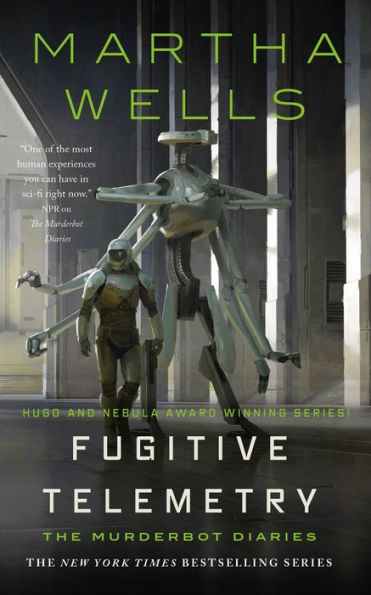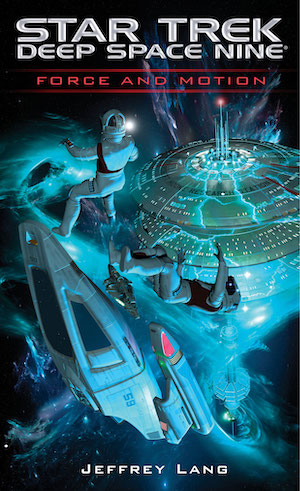Ascendance
Jeffrey Lang
Publication Date: June 2016
Timeline: early January 2386; numerous flashbacks, going back almost four decades
Progress: With the 2381 Borg attack underway, Benjamin Maxwell, last referenced in this reread series in Gateways #4: Demons of Air and Darkness, is serving time at the Starfleet Penal Colony on Waiheke Island, New Zealand, Earth. He applies to serve in the effort to repel the Borg, but his application is turned down (a major concern is that the Cardassians fighting on the Federation side would react poorly to his presence).
A further series of scenes, which act as flashbacks with respect to the novel’s “present” of 2386, depict Maxwell’s rehabilitation with various therapists, his clearance to leave the colony, and some of the places he visits and things he does (including saving a civilian ship under attack from space pirates) on the way to his eventual low-key job on the space station Robert Hooke.
It is here that Miles O’Brien and Nog encounter Maxwell, who supports the station’s basic maintenance—or acts as its “janitor,” as Anatoly Finch, the guy running the place, less kindly puts it. The station is a privately held enterprise, owned by an Orion bank, with Finch the principal landlord. Working directly for Finch is Sabih Ali, who specializes in communications and acts as Finch’s right-hand man. The station itself is home to various unconventional scientists developing far-out projects, including “a Tellarite cyberneticist who is developing a means for telepathic communication with autonomous robots.” Doctor Nita Bharad, another prominent researcher onboard Hooke, has, among other accomplishments, developed two artificial “arachnoform” beings named Ginger and Honey that soon impress (and scare) O’Brien and Nog.
O’Brien has basically engineered this trip to check up on Maxwell—his old Captain aboard the Rutledge prior to his infamous fall from grace—and to help Nog clear his head a bit in the process. Naturally, once they arrive on the station, prospects of idle time soon evaporate. An entity that Finch has called the Mother—“ the basis for all the programmable cells I create. She is modular, undifferentiated, but it takes only a few adjustments to create viable descendants”—is accidentally released, and Sabih appears to be killed, and his body then controlled, by the Mother.
A complicated series of maneuvers by Maxwell, O’Brien, Nog, and Bharad, involving various spacecraft, EVAs, BASE jumps, and displays of scientific ingenuity, are needed to address Hooke’s escalating problems and save the lives of its denizens. Finch, whose entire motivation is financial, is revealed to have a Romulan customer named Cretak waiting for receipt of the Mother, but the rapidly deteriorating situation prevents that transaction from ever being completed. In the end, Maxwell performs what appears to be a self-sacrificial act to save the group, but a subsequent epilogue reveals that he managed to sidestep oblivion and is out there somewhere, seeking a fresh start.
Behind the lines: This is a quirky adventure, a diverting enough offshoot from the main DS9-related narrative developed, primarily, by David R. George III over the course of a half-dozen books in this series. If you thought O’Brien and Nog weren’t getting enough page time recently, rest assured, this outing makes up for that deficit. How much you appreciate Lang’s effort will depend, to some degree, on how much you click with his offbeat imagination and humor, and on how comfortable you are knowing that this narrative plays out like an extended B-story from an ordinary episode of the series, told in a heavily non-linear manner.
I think Lang’s biggest literary success here is in depicting Maxwell’s evolution over time. How is someone responsible for the loss of so many lives treated by Federation counselors? Can you ever truly recover from something on the scale of what Maxwell did? How do the perceptions of others change, sometimes in unexpected ways? Maxwell’s foregrounding, and his past connection to O’Brien, admittedly infuse the novel with a bit of a TNG sensibility, but Lang ably and organically grows that into more of a DS9 “feel” as the story progresses, mostly by relying on Hooke’s environment for the bigger physical set pieces. I enjoyed learning of the dependability of O’Brien in Maxwell’s life:
Miles O’Brien had been a constant, gracious presence. The chief never intruded, but Maxwell always knew he could count on his old tactical officer for a moderately raucous note and a bottle of real Bushmills on his birthday.
Buy the Book


Fugitive Telemetry
In terms of the character work, the flashbacks involving Nog and Jake were another highlight, as were some, but not all, of O’Brien’s. Specifically, his pre-Keiko relationship scenes with Naomi Chao fell flat, and that particular arc seemed to have no payoff, since Chao eventually simply resigns her commission and disappears from the book. Nog’s restlessness was well handled. Finch, on the other hand, comes across as cartoony (e.g., “‘I’m a genius,’ Finch said, grinning maniacally”) but not in a particularly entertaining way. Sabih is entirely disposable. Nita Bharad (is her name a stealth nod to the famous phrase “Klaatu barada nikto” from The Day the Earth Stood Still?) fares better, but is perhaps outshined by her creation, the arachnoforms Ginger and Honey. Non-humanoid aliens are always a refreshing and welcome change of pace in Trek, and Lang gives both of these distinct personalities, albeit at times admittedly anthropomorphized by our point-of-view characters. Maxwell’s interactions with them were quietly compelling and, in a way, moving. I’m glad they survived! Lastly, introducing Cretak some 290 pages in seems like a misfire; it’s too late to become invested in his perspective–why not omit his viewpoint, or if not, introduce it earlier via the flashback route?
Unabsorbing for me, pun intended, was the Mother. This being feels more like a creature out of Alien or The Abyss or Life, though I can see what Lang was going for. Maybe the element that distracted me most about the Mother’s plot contribution was that her being jettisoned into the vacuum, surviving, and then wrapping herself around various external surfaces and seeking energy seems overly reminiscent of the biomimetic half of Ascendance. Thematically, she resonates more strongly. The idea of motherhood is explored in multiple ways throughout the novel: Bharad as the mother of Ginger and Honey, Maxwell’s conversation with Brody in Chapter 6 regarding the death of Maxwell’s mom, O’Brien’s recollections of his own mother, Megan, in Chapter 13 (one of the flashbacks I did enjoy), and so on. Lang’s use of the “what is the best/worst day you’ve ever had?” question as a way to elicit important moments from various characters dispersed in the timeline became gimmicky by dint of its repetition, though I do acknowledge the relevance of its therapeutic context.
I wish there had been more follow-up on the necessity of ecological clean-up of the huge mess left behind by the Borg. “Worlds lie burning,” Finch tells us, “their citizens not even given the grace and dignity of a peaceful resting place, their lands toxic, their atmosphere defiled, their oceans venomous.” Sure, some of that may be hyperbole as part of his sales pitch, but even if it’s only fractionally true, it would have been nice to revisit this towards the book’s conclusion. There were, at least, other scattered nuggets of neat worldbuilding. This was my favorite: “O’Brien counted to ten in his head and let his stomach settle. The suit’s medical program must have sensed his discomfort and pumped something into him. Nausea dissipated and his mind cleared.”
On balance, the numerous action scenes seemed mechanical and perfunctory compared to the more interesting character dynamics of the quieter moments, both present and past. Ironically, then, this novel is most effective in its instances of least “force and motion.” I was thankful for a little downtime from complicated, conspiratorial politics and huge, galaxy-spanning events, but overall I found this material somewhat hit-and-miss.
Memorable beats:
O’Brien: “I miss Julian.”
Michael Clark: “I’m sorry, Ben, truly sorry if I let you leave thinking you had somehow been fixed—as in, no longer broken. Psychiatry, therapy, psychoanalytics—whatever you want to call it—doesn’t work that way. You’ll always be broken. Or have been broken. Some terrible things happened to you.”
Nog to O’Brien: “Let’s never, ever, ever leave the station together.”
Orb factor: Entertaining but drawn out; 6 orbs.
In our next installment: We’ll be back in this space on Wednesday November 25th with Rules of Accusation by Paula Block and Terry J. Erdmann!
Alvaro is a Hugo- and Locus-award finalist who has published some forty stories in professional magazines and anthologies, as well as over a hundred essays, reviews, and interviews. Nag him @AZinosAmaro.










